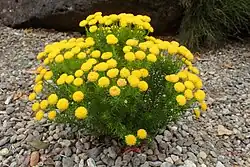Chrysocoma cernua
| Chrysocoma cernua | |
|---|---|

| |
| Scientific classification | |
| Kingdom: | Plantae |
| Clade: | Tracheophytes |
| Clade: | Angiosperms |
| Clade: | Eudicots |
| Clade: | Asterids |
| Order: | Asterales |
| Family: | Asteraceae |
| Genus: | Chrysocoma |
| Species: | C. cernua
|
| Binomial name | |
| Chrysocoma cernua L.
| |
| Synonyms[1] | |
| |
Chrysocoma cernua is a species of flowering plant from the family Asteraceae.[1] It is known by many common names including: shrub goldilocks,[2] golden heads, golden bitter bush,[3] golden cowcud[4] or golden hair.[5]
Description
Chrysocoma cernua is an erect leafy shrub, which grows up to 50 cm tall.[6] Plants are perennial and possess green linear leaves.[7] The leaves are hairless, slightly flattened and curved upward.[7] Flowers are positioned on the ends of stems and are yellow or golden in colour. Blooms are discoid and button-like in shape.[6]
Distribution and habitat
Chrysocoma cernua is endemic to South Africa, where it can be found growing in the Cape Provinces[1] of the Northern Cape and Western Cape.[8]
The species has also been introduced into the United Kingdom,[1] where it has become naturalized and Australia, where it has become an invasive species.[9]
References
- ^ a b c d "Chrysocoma cernua". Plants of the World Online. Royal Botanic Gardens, Kew. Retrieved 4 May 2022.
- ^ "Shrub Goldilocks". www.seasonalwildflowers.com. 2022-05-04. Retrieved 2022-05-04.
- ^ "Golden Heads Chrysocoma coma-aurea". candide.com/ZA. 2022-05-04. Retrieved 2022-05-04.
- ^ "Golden Heads Chrysocoma coma-aurea". candide.com/GB. 2022-05-04. Retrieved 2022-05-04.
- ^ "Chrysocoma coma-aurea". www.nzpcn.org.nz. 2022-05-04. Retrieved 2022-05-04.
- ^ a b "Chrysocoma coma-aurea". Fernkloof Nature Reserve Hermanus Botanical Society. 2022-05-04. Retrieved 2023-04-01.
- ^ a b "Chrysocoma coma-aurea". jstor.org. 2022-05-04. Retrieved 2022-05-04.
- ^ "Chrysocoma cernua L." redlist.sanbi.org. 2022-05-04. Retrieved 2022-05-04.
- ^ "Chrysocoma coma-aurea". Global Biodiversity Information Facility. Retrieved 4 May 2022.